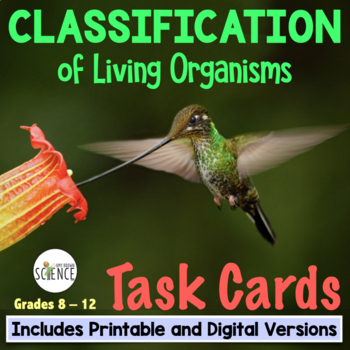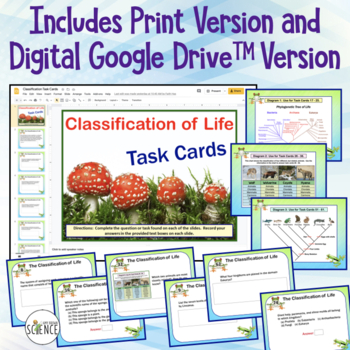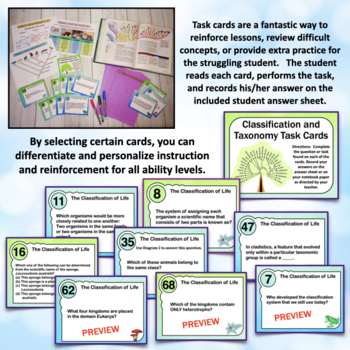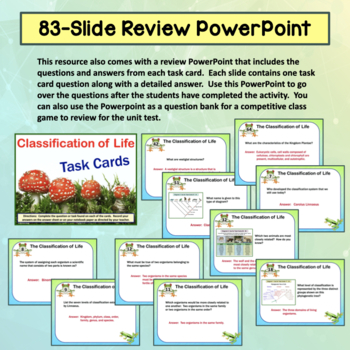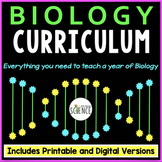Classification of Living Things Task Cards
- Zip
- Google Apps™

What educators are saying
Also included in
- This complete teaching unit on classification and taxonomy includes everything you need to teach this unit to your life science or biology students. Many of the resources are available in BOTH printable and digital formats. Resources include a 71-slide PowerPoint presentation packed with colorfulPrice $43.99Original Price $58.71Save $14.72
- This NO PREP, PRINTABLE, EDITABLE, AND DIGITAL Biology Curriculum contains everything you need for an entire year of Biology! For less than $3 a day, you can save your time, energy, and sanity. Each of the 20 Complete Units includes a teaching PowerPoint presentation, notes, labs, homework assignmenPrice $525.00Original Price $988.18Save $463.18
Description
This set of 77 enrichment, reinforcement, and review task cards for your lessons on "The Classification of Living Organisms" will ensure that your students have mastered the information. Choose to use the traditional printable version, or the paperless, digital Google Apps version. Questions cover early attempts at classification, the Linnaean system, binomial nomenclature, phylogeny, cladistics, cladograms, the three domains, a comparison of kingdoms, and much more! Detailed list of concepts can be found below.
Suitable for life science and biology students in grades 9 - 12.
Both printable and digital versions of this resource are included. The student handouts can be printed or used in the paperless digital format in your Google Drive, Google Classroom, Microsoft OneDrive, or similar. This resource is perfect for traditional classroom settings, 1:1 schools, or for distance learning.
What is included in this product?
- A set of 77 FULL COLOR printable and editable task cards.
- A set of 77 LOW-INK printable and editable task cards.
- Paperless Digital Version (not editable) for use in Google Drive, Google Classroom, and /or Microsoft OneDrive
- Teacher Guide containing tips, directions and suggestions.
- A student answer sheet for recording answers.
- Blank task cards so that you can add additional questions.
- A complete teacher answer key.
- A teacher answer key Review PowerPoint that can be used to go over answers with the students.
- Teacher Guide for Google Apps
Task cards are a fantastic way to enrich or reinforce lessons, review difficult concepts, or provide extra practice for the struggling student. The student reads each card, performs the task, and records his/her answer on the included student answer sheet.
From the moment of purchase, you will be ready to use your task cards in just a few minutes. Simply print the sheets of task cards on card stock paper, laminate, and cut the cards apart. The cards look best when printed in color, but they can easily be printed in black and white.
This set of 77 task cards on scientific classification will cover the following:
- The need for a system of classification.
- Summary of Darwin's Theory of Evolution.
- Definition of taxonomy.
- Early attempts at classification: Aristotle, misuse of common names.
- Linnaeus: Seven levels of classification, binomial nomenclature, definition of species, the rules of binomial nomenclature.
- Modern taxonomy: phylogeny, phylogenetic tree, reading a phylogenetic tree, practice questions.
- Modern taxonomy is based on: structural similarity, cellular organization, evolutionary relationships, biochemical similarities, genetic similarities, embryological similarities.
- Homologous, analogous, and vestigial structures: Definitions and examples.
- Cladistics and cladograms: Definitions, clades, out-groups, in-groups, shared characters, derived characters, and examples.
- Cladistics and cladograms: Students will look at cladogram and answer questions.
- Three domain system of classification.
- Comparison of kingdoms in the 6-kingdom system.
- For each kingdom, students answer questions about the characteristics, cell types, distinguishing cell structures, cellular organization, methods of food-getting.
Related resources include:
Kingdoms of Life Mix and Match Card Game
Classification PowerPoint and Notes Set
Classification Using a Dichotomous Key
Insect Dichotomous Key Activity
Dichotomous Classification Key to Thanksgiving Dinner
Dichotomous Key to the Genus "Smiley"
Evolution and Classification: Warm Ups, Bell Ringers and Interactive Notebooks
Test: Classification and Diversity of Life
Lab: The Use of Dichotomous Keys in Classification
Dichotomous Classification Key to a "Crazy" Animal Kingdom
Classification and Taxonomy Jeopardy Review Game
Learning to Use and Construct a Dichotomous Classification Key
Classification Crossword Puzzle
Classification (Taxonomy) Homework or Study guide
Activity: Let's Build a Cladogram!
Classification and Taxonomy Quiz
For updates about sales and new products, please follow my store:
My TpT Store: Amy Brown Science
You can find me at these locations as well:
My Blog: Amy Brown Science.com
Instagram: @AmyBrownScience

